Even though education was a high priority, Justo cites a well-rounded childhood and a balanced life as the foundation of his success.
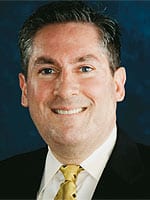
Emilio M. Justo, MD
Sun City West, Ariz
Emilio M. Justo, MD, a board-certified eye physician and cosmetic surgeon, is also the founder and medical director of the Arizona Eye Institute & Cosmetic Laser Center, in Sun City West (near Phoenix).
Founded in 1989, Justo’s center offers a variety of procedures including cataract surgery with premium lens implants; blepharoplasty; facelifts, endoscopic browlifts, and liposuction; as well as many nonsurgical procedures, such as permanent makeup, skin care, chemical peels, Botox and Dysport, tissue fillers, microdermabrasion, laser hair removal, and sclerotherapy.
Justo is committed to creating a personal rapport with his patients and an open dialogue to address any questions or concerns. He says he is inspired by human contact and positive relationships to create benefits that improve vision and self-esteem in patients of all ages.
Justo and his parents came to the United States as refugees from Communist Cuba when he was a toddler. At the age of 3, his family settled in Northwest Indiana, close to Chicago, and started a whole new life.
Justo’s parents emphasized education, and, as with many immigrants, were motivated to work hard and make the most of the opportunities available in America. Growing up, there was never any doubt that Justo would attend college.
“My first choice as a career was to be a professional baseball player,” Justo says with a smile. “There were some raised eyebrows when I told my parents I wanted to be a Major League pitcher, but then what young boy doesn’t want to play in the big leagues?”
Involved in sports and extracurricular activities throughout his childhood, Justo also naturally gravitated toward science and biology. At some point, he knew he would attend medical school, though his specialty had yet to be defined.
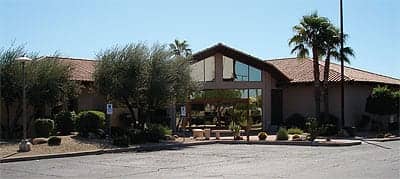
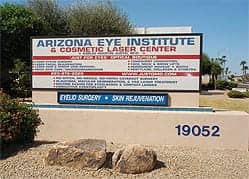
“When I started my studies at the University of Michigan, I noticed a lot of specialties had their own personalities,” he explains. “It’s kind of like a TV drama—the general surgeons tended to be very focused and driven, while the internal medicine doctors could have been described as nerds. The ophthalmologists seemed to be the most ‘normal’ when I compared them to the other specialties, and that really made an impression on me.”
Justo finished medical school at 23 years old—much younger than most of his classmates and peers—and started his eye practice in Arizona at 27 as the youngest ophthalmologist in the state at the time.
His drive comes as a direct result of his upbringing. He watched his parents work hard to provide for the family and establish a disciplined, dedicated home that inspired him to work hard, as well. Even though education was a high priority, Justo cites a well-rounded childhood and a balanced life as the foundation of his success.
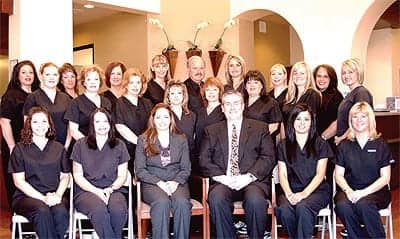
Life in the Sun
Justo admits he came to the metropolitan Phoenix area in 1989 for the weather. He had enough of Midwest winters and looked forward to sunshine and warmer temperatures. At that time, he started a traditional ophthalmologic practice, even though he had undergone extensive oculoplastic surgical training as a resident.
Intrigued by the opportunities of adding “non-traditional” plastic surgery services to his ophthalmology practice, he completed hundreds of hours of continuing education, including didactic seminars, cadaver labs and viewed a multitude of live surgeries to gain knowledge. In 1996, Justo began using the CO2 laser exclusively for all of his blepharoplasty procedures, as well as becoming one of the first surgeons in the Phoenix area to offer CO2 laser resurfacing as part of his service offering.
“Laser resurfacing was really in its infancy then, and I was the only one in the area I know about who was using it routinely at the time,” he says.


Over the next several years, he continued completing additional education, surgery workshops, and other requirements. Once his training was solidified, he began integrating other procedures into his practice—face, neck, and endoscopic browlifts soon became part of his offering to patients. Eventually, he added liposuction to the mix after he completed training with Jeffrey A. Klein, MD, the California-based physician who invented tumescent liposuction, among many other well-known liposuction surgeons.
“Now there are probably a handful of ophthalmologists who offer these kinds of procedures, but most really just perform traditional ophthalmologic procedures and don’t offer anything related to plastic surgery,” he says.
Growing with the Market
Justo opened a satellite office in Wickenburg, Ariz, in 1994, and in 1999 built a medical office building in Sun City West housing both his medical practice and optical boutique/dispensary, as well as containing his Arizona state-licensed surgery center.
Today, the Wickenburg office is staffed by primarily by his optometrist, who handles eye exams and related services for the nearby community, while Justo spends most of his time at the Sun City and Sun City West offices.
The Sun City West ambulatory surgery center, which is Medicare-certified and AAAHC-accredited for outpatient surgeries, is unique because, “Depending on the procedure,” Justo explains, “it may require general anesthesia or in certain cases local anesthesia may be sufficient, so our procedures really run the gamut.”
Being Medicare-certified means the center offers procedures that are covered by both commercial and Medicare insurance. For example, upper eyelid surgery improves peripheral vision and can relieve eyestrain and fatigue, so it may be defined as a medical procedure, especially in the more severe cases of functional blepharoptosis in the elderly, and not just an elective one.
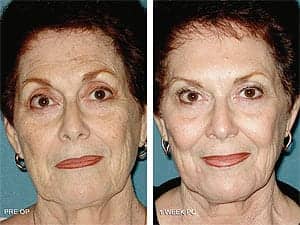
Before and after of “Active FX” fractional laser resurfacing of the face and neck using the Lumenis Encore laser.
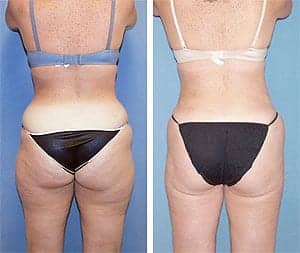
Before and after tumescent liposuction of the abdomen, hips, and outer thighs.
The Sun City West center has evolved as Justo’s primary office, mostly because of the surgery center, but also because this medical office building is quite spacious, allowing for both cosmetic treatment and laser suites for his registered nurses, as well as for traditional eye examination lanes. The center also houses two separate reception lobbies, one for ophthalmic patients and the other for cosmetic patients.
The original Sun City office now offers mainstream ophthalmologic services and employs an optometrist 4 days every week. Justo spends 1 day per week at the Sun City location, just to keep his finger on the pulse of that patient base.
Practice Evolution
Justo cites the evolution of his practice into the plastic surgery world as quite intentional.
“I really enjoyed oculoplastics from my days of residency training,” he says, “and, in the late 1990s, health care was really starting to change. I saw plastics as a way to branch into a fee-for-service environment and not be restricted solely by Medicare or other insurance limitations.”
Over time, Justo and his staff gradually integrated a broad range of services that feed one another. “A patient who comes in for a functional upper eyelid surgery may opt to add a lower lid blepharoplasty or even a Botox session to address wrinkles causing crow’s feet,” he says.
Patients are offered a wide range of options, from cosmetic surgery procedures including facelifts and necklifts to nonsurgical cosmetic procedures (such as laser hair removal, microdermabrasion, chemical peels, spider veins, and permanent makeup).
Ancillary staff provides most nonsurgical services, though Justo prefers to perform Botox injections and other tissue fillers personally.
“Our services really lend themselves well to internal referrals,” he says. “And it goes both ways—a patient coming in for permanent makeup may decide that to get the best result they should do an eyelid lift first; or, a patient coming in for a traditional eye exam may decide to take advantage of our skin care offerings while they are in the office.”
December 2010 marked the rollout of hearing care at Justo’s center. “It feels like a natural evolution,” he says. “Many of our patients have hearing care needs in addition to their vision care needs, so we are adding a hearing care practitioner and will offer audiology testing for patients, as well as dispensing hearing aids.
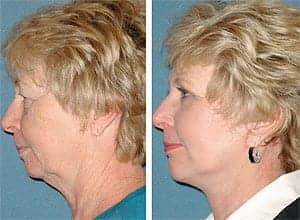
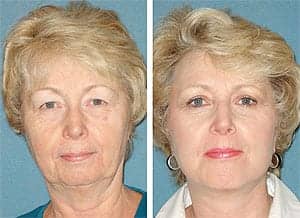
Before and after photo of facelift with upper eyelid blepharoplasty.
“Hearing and vision are such a big part of our daily life rituals, and dual sensory loss has been scientifically documented to exponentially diminish a person’s quality of life,” he notes. “We want to be the health care provider that helps people enjoy life and feel good about themselves.”
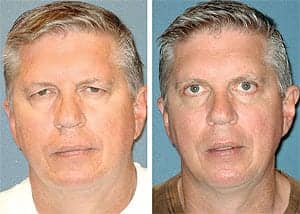
Before and after upper and lower eyelid surgery (laser blepharoplasty).
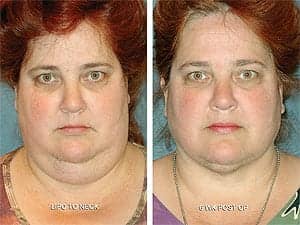
Before and after tumescent liposuction of the neck (tumescent local anesthesia only).
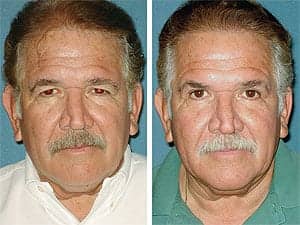
Before and after photo of laser upper eyelid blepharoplasty under local anesthesia.
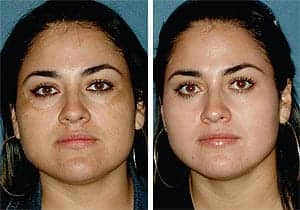
Before and after Obagi Nu-Derm skin care with Obagi Blue Peel to reduce melasma and hyperpigmentation.
Driving the Changes
Justo cites a couple of factors as the major forces behind the growth of his practice: self-image and quality of life.
“As we all age, we naturally want to maintain our appearance and be as attractive as possible,” he says. “And also as we age, our vision and hearing need maintenance to perform at their optimum levels.”
In addition, Justo says his patients have been a driving force, spreading the word about the variety and quality of services offered at his facilities and sending their friends to him for a consultation.
Whereas the centers originally started with an ophthalmologic focus, over the years eyelid surgeries have increased exponentially and today they outpace even cataract surgeries. In a typical week, Justo performs a dozen or more eyelid surgeries—some are cosmetic and some to address peripheral vision issues. Cataract surgeries trend to around 10 to 12 procedures in a particular week.
Justo’s practice breaks down to about 60% ophthalmologic and 40% cosmetic on the first visit, with each patient’s involvement at the center dependent upon his or her own personal needs, he notes.
Patient Relationships
Justo believes successful relationships with his patients are about more than just a good outcome, whatever the reason for their initial visit. A natural performer, he believes in establishing rapport on the telephone as well as in person.
He and his staff enjoy an ongoing joke, as in every time Justo or one of his staff walks into an exam room he asks everyone, “When I walk into this room, who am I?” The answer, according to Justo, is to become an actor on stage.
“At that moment, no matter what else is going on in my life, my full attention is on that patient,” he explains. “I want to help them get rid of any nerves, talk face-to-face, and learn about them as an individual—hear about any trips they’ve taken recently, any hobbies, etc. This helps us both break the ice and then get down to addressing their needs and questions in a mutually sincere, honest, and trusting conversation.”
Justo believes this attention helps the patients feel good about the experience, whether they are coming in for a cosmetic consultation, pre- or postoperative visit, or a comprehensive dilated eye examination.
Though Justo offers a wide variety of services and procedures, he purposely focuses on those that work well as part of a complete solution for his patients. For example, most patients who come in for eyelid surgeries also opt to have some laser resurfacing work done around the eyes to reduce fine lines and wrinkles.
From a cosmetic perspective, he believes strongly in the effectiveness of the CO2 laser in resurfacing procedures. Although many physicians favor nonablative lasers, Justo says that his patients tend to favor a more intense approach that does not require repeated sessions and also provides more visible results.
Justo’s conversion to laser eyelid surgery is a big benefit for patients, and few ophthalmologists perform this kind of procedure on a routine basis. The Sun City West Surgical Center allows him to perform this procedure on-site for his patients, he says, and this allows for quicker recovery.
“Cataract surgery is an area where we’ve made huge strides over the years,” he continues. “Incisions in cataract surgeries used to be between 10 and 12 mm and required 8 to 10 stitches, as well as an anesthetic that paralyzed the eye and required the wearing of an eye patch postprocedure for 24 hours.”
Currently, he says, a typical cataract surgery requires only an incision of about 2.4 mm and no stitches, along with a an eye drop (topical) anesthesia. Patients can now even go home without the “pirate patch.”
Community and Service
Justo is committed to giving back to the community, and has participated in a variety of pro bono initiatives. With his wife and two young boys at his side, his main focus is on family and community. He talks about working hard and providing the kind of example his parents gave to him, and looks forward to watching his children grow and learn.
“That’s why my wife and I focus so much on giving back to children in need,” he says. “In so many cases, all it takes is one good experience to help a child choose the right path in life.”
Schae Kane is a regular contributor to PSP. She can be reached at [email protected].


